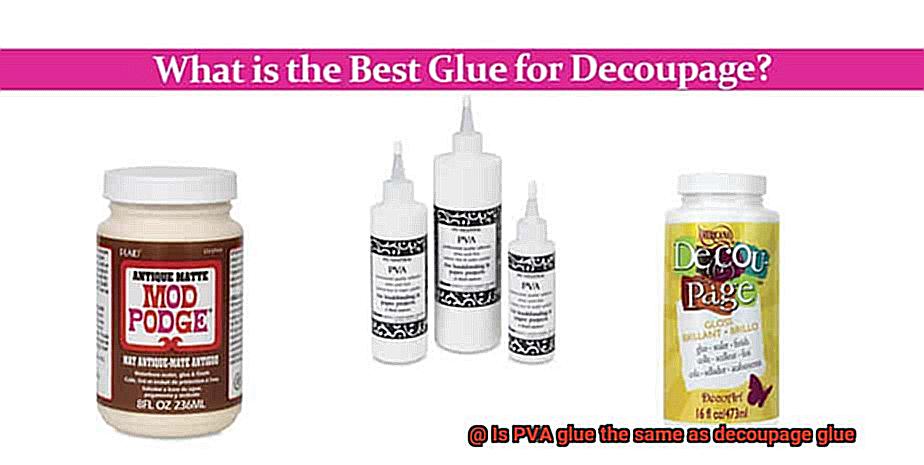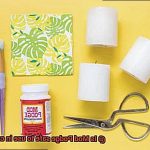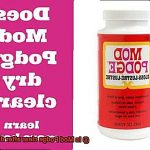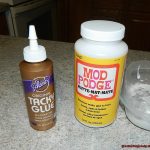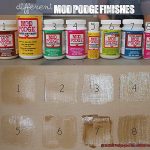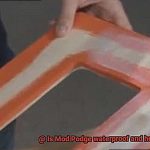Picture this: you’re in the midst of a thrilling DIY project, armed with scissors, colorful paper, and an abundance of creativity. But wait. You need glue to bring your masterpiece together. As you wander down the glue aisle, confusion strikes – PVA glue or decoupage glue? Are they long-lost twins separated at birth or distant cousins with their own unique traits?
Fear not, my fellow crafters. In this blog post, we embark on a mission to demystify the enigma surrounding PVA glue and decoupage glue. We’ll delve into their similarities and differences, uncovering the secrets behind these adhesive wonders. So buckle up and get ready for a wild ride as we explore their distinct properties, suitable applications, and all the juicy details that will elevate your crafting game.
Get ready to make informed decisions and unleash your creativity like never before. Let’s dive headfirst into this captivating world of glues and discover which one reigns supreme for your artistic endeavors.
What is PVA Glue?
Contents
- 1 What is PVA Glue?
- 2 What is Decoupage Glue?
- 3 Composition of PVA and Decoupage Glues
- 4 Adhesion of PVA and Decoupage Glues
- 5 Application of PVA and Decoupage Glues
- 6 Finishing Results of PVA and Decoupage Glues
- 7 Versatility of PVA and Decoupage Glues
- 8 Comparison Between PVA and Decoupage Glues
- 9 Conclusion
Crafting and DIY projects ignite the spark of creativity, allowing us to bring our imaginations to life. And at the heart of every successful project lies PVA glue. In this article, we will immerse ourselves in the captivating world of PVA glue, exploring its remarkable properties, diverse applications, and why it has become an indispensable staple for crafters worldwide.
Properties of PVA Glue:
- Water-based Marvel: Unlike its solvent-based counterparts, PVA glue’s water-based formula ensures a safe and odorless crafting experience. No more suffocating fumes or concerns about toxicity in enclosed spaces.
- The Art of Transparency: PVA glue dries clear, ensuring an invisible bond that seamlessly blends into your projects. A touch of magic that allows your creations to shine.
- Versatility Unleashed: PVA glue’s remarkable versatility enables it to bond an extensive range of materials. From wood and paper to fabric, leather, and cardboard, there are no boundaries to what you can create.
- Dilution Mastery: With the ability to be easily diluted with water, PVA glue grants you complete control over its application. Say goodbye to visible brush strokes or uneven coverage as you embark on your crafting journey.
Applications of PVA Glue:
- The Paper Oasis: Whether you’re crafting scrapbook pages, fashioning intricate greeting cards, or shaping origami masterpieces, PVA glue provides an unwavering bond for all your paper creations.
- Woodworks Wonders: When it comes to woodworking projects, PVA glue formulated specifically for this art form exhibits unparalleled bonding strength, able to withstand the test of time and the rigors of wood joints.
- Fabric Alchemy: Transforming fabric into works of art? PVA glue designed for fabric bonding offers the flexibility and durability needed without leaving residue or causing harm to your precious textiles.
- Collage Magic: PVA glue’s chameleon-like qualities make it an exceptional choice for collages, allowing you to securely attach an array of materials to your artwork, from feathers to beads and beyond.
PVA Glue vs. Decoupage Glue:
While PVA glue and decoupage glue share similarities, key differences set them apart:
- Composition Secrets: PVA glue is crafted from polyvinyl acetate, while decoupage glue often incorporates additional ingredients like resins or varnishes for enhanced durability.
- Adhesion Mastery: PVA glue boasts excellent adhesion to porous materials, while decoupage glue specializes in adhering paper to surfaces such as wood or glass, providing a glossy or matte finish.
- The Art of Application: PVA glue’s easy application allows for longer drying times, granting you the freedom to reposition your work. In contrast, decoupage glue’s thicker consistency results in quick drying and potential need for multiple coats.
What is Decoupage Glue?
Prepare to embark on a journey into the world of creativity and craftsmanship, where ordinary objects are transformed into extraordinary works of art. At the heart of this magical transformation lies decoupage glue, the secret ingredient that brings together materials, adds a touch of transparency, and protects artistic masterpieces. In this captivating article, we will unravel the mysteries behind decoupage glue, exploring its remarkable properties, diverse applications, and why it’s an absolute essential for any crafting enthusiast.
The Power of Bonding:
Decoupage glue is no ordinary adhesive; it possesses a unique formula designed to create an unbreakable bond between materials. Delicate paper or lightweight fabric? Not a problem. Decoupage glue ensures that your carefully chosen cutouts adhere securely to any surface, withstanding the test of time and preserving your artistic vision.
Transparency is Key:
Witness the invisible touch of decoupage glue as it dries clear, seamlessly blending with the materials it binds. Say goodbye to unsightly adhesive streaks that mar your artistic creations – decoupage glue ensures a polished and professional finish, allowing your creativity to shine without interruption.
Protect and Serve:
Decoupage glue is not just an adhesive; it’s also a guardian, shielding your artwork from moisture, dust, and the wear and tear of everyday life. By applying a protective layer of decoupage glue over your cutouts, you enhance their longevity while adding a glossy and refined look to your creations.
Liquid or Gel? You Decide:
The world of decoupage glue offers choices to cater to every artist’s preference and project requirements. Liquid decoupage glue flows smoothly, providing effortless application for those seeking ease and grace. On the other hand, gel formulas offer thicker consistency, minimizing drips and providing precise control over adhesive placement.
Beyond the Boundaries of Decoupage:
While decoupage glue is the shining star of decoupage projects, it refuses to be confined to a single art form. Crafters and artists alike can harness its adhesive strength and protective qualities for a wide range of crafts and art applications. From mixed media collages to fabric art, decoupage glue is the versatile adhesive that elevates every project.
Decoupage Glue vs. PVA Glue:
It’s important to note that decoupage glue stands apart from its cousin, PVA glue. While both possess adhesive properties, they differ in crucial ways. Decoupage glue’s transparent and protective formula ensures a flawless finish, while PVA glue may dry with a slightly yellowish tint and lacks the same level of protection.
Composition of PVA and Decoupage Glues
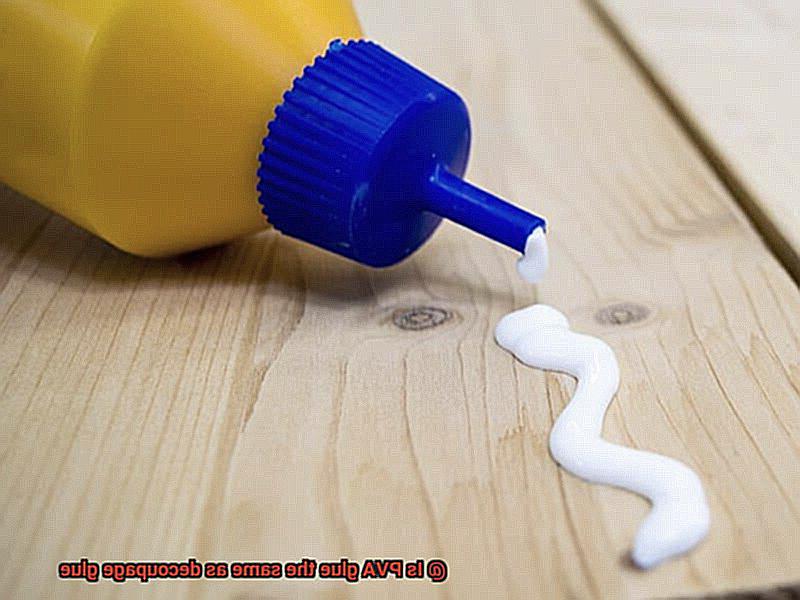
Glue may seem like a mundane topic, but it plays a pivotal role in countless artistic and crafting endeavors. Whether you’re an experienced crafter or just dipping your toes into the world of creativity, understanding the composition of different types of glue can help you choose the perfect adhesive for your project.
Let’s start with PVA glue, also known as white glue or wood glue. What makes this type of glue so versatile? It all comes down to the main component: polyvinyl acetate. This synthetic polymer is derived from vinyl acetate monomers that undergo a process called polymerization. This process creates long chains of polyvinyl acetate molecules, giving PVA glue its remarkable adhesive properties. It’s no wonder that PVA glue is a go-to choice for crafts and woodworking projects.
Now, let’s dive into the world of decoupage glue. Decoupage glue is specially formulated for decoupage projects, which involve adhering paper or fabric cutouts to various surfaces. One well-known brand of decoupage glue is Mod Podge. What sets decoupage glue apart from PVA glue? It’s all in the composition. Decoupage glues like Mod Podge combine PVA glue with water, solvents, and additives. These additional ingredients enhance the flexibility and moisture resistance of the glue, making it perfect for adhering delicate paper or fabric cutouts onto surfaces.
When it comes to performance, there is a notable difference between PVA glue and decoupage glue. While PVA glue can certainly be used for decoupage projects, it may not offer the same level of flexibility and durability as dedicated decoupage glues. Decoupage glues are specifically designed to bond paper and fabric to surfaces while providing a clear, glossy finish.
So, when choosing between PVA glue and decoupage glue, it’s essential to consider the requirements of your project. If you need a strong adhesive for woodworking or general crafts, PVA glue is a reliable choice. However, if you’re working on a decoupage project that calls for flexibility and a glossy finish, opt for a dedicated decoupage glue like Mod Podge.
Adhesion of PVA and Decoupage Glues
Glue, the unsung hero of the craft world, possesses the mighty power to transform ordinary materials into extraordinary creations. But with a plethora of options available, how does one choose the right glue for their project? Today, let us delve into the realm of adhesives and explore the intriguing differences between two popular choices: PVA glue and decoupage glue.
Let us begin with PVA glue, also known as white glue or wood glue. This versatile adhesive stands as a staple in every crafter’s arsenal. Crafted from polyvinyl acetate, PVA glue forms an unyielding bond when it dries, rendering it ideal for an array of materials such as wood, paper, fabric, and cardboard. Its thick consistency permits effortless application and guarantees a secure hold. Moreover, it dries clear and flexible, making it perfect for projects that demand durability without sacrificing aesthetics.
On the other hand, we have decoupage glue – the shining star of the decoupage world. Decoupage, an art technique involving the decoration of surfaces with cut-out paper or fabric sealed by layers of glue, finds its perfect match in decoupage glues like the ever-popular Mod Podge. Expertly formulated, these glues offer a smooth and glossy finish. Often thinner and more fluid in consistency than PVA glue, they effortlessly glide onto surfaces in thin layers. Additionally, decoupage glues contain special additives such as resins or varnishes that enhance adhesion, durability, and resistance to moisture and UV light.
Now let us examine their adhesion properties. While both PVA glue and decoupage glue effectively adhere paper or fabric to various surfaces, their differences lie in their intended use and formulation. PVA glue takes center stage for general crafting and woodworking projects that require a sturdy bond without specific finishing requirements. On the other hand, if you find yourself immersed in a decoupage project that mandates a smooth and glossy finish, decoupage glue is your guiding light.
It is crucial to note that some decoupage glues on the market actually contain PVA as their main ingredient. In these cases, the dissimilarity lies in the additional additives and formulation designed specifically for decoupage projects. Thus, always ensure you peruse the label to ensure you select the appropriate glue for your unique needs.
Application of PVA and Decoupage Glues
Today, we are diving headfirst into the captivating world of glues, uncovering the distinctive qualities of PVA glue and decoupage glue. While they may appear similar at first glance, these glues have their own unique characteristics that make them ideal for different projects. So, let’s delve into the nitty-gritty details.
First off, let’s talk about application. PVA glue is your trusty sidekick for all crafting endeavors. It can be applied to a wide array of materials such as paper, fabric, wood, and even some plastics. On the other hand, decoupage glue takes center stage in decoupage projects. It not only provides a robust bond but also acts as a sealer and finisher, giving your creations that extra wow factor.
Now, let’s move on to consistency. Picture this: PVA glue gracefully gliding across surfaces with its thin and runny texture, effortlessly spreading its adhesive magic. This makes it perfect for gluing paper or fabric together or adhering embellishments to surfaces. In contrast, decoupage glue struts in with a thicker consistency that allows for better control when applying it to intricate designs or delicate surfaces. Precision at its finest.
Drying time. PVA glue struts its stuff once again, drying faster than you can say “craftastic.” This makes it ideal for projects that require quick assembly or immediate use. Decoupage glue, however, likes to take its sweet time to fully dry and cure, especially when multiple layers are involved. Patience is a virtue.
Lastly, let’s talk durability. PVA glue is like the reliable friend who’s always there for you when you need them. It’s great for general crafting purposes but may not provide the same level of durability and protection as decoupage glue. Decoupage glue takes the spotlight with its superpowers of strength and resilience, designed to withstand wear and tear over time. It also acts as a sealant, shielding your masterpiece from moisture and damage.
So, next time you embark on a crafting adventure, remember to consider the specific requirements of your project. If you crave versatility and flexibility across various materials, reach for PVA glue. But if you’re after a strong bond with a glossy finish, decoupage glue is your go-to hero. Don’t forget to read the labels and choose the glue that suits your unique needs.
Finishing Results of PVA and Decoupage Glues
These seemingly similar glues possess their own distinct qualities that make them perfect for different projects. So, let’s dive deep into the intricate details and discover their magical powers.
Application Techniques:
PVA glue, the trusty sidekick, effortlessly adheres to a wide range of materials like paper, fabric, wood, and even certain plastics. Its thin and runny texture allows for easy spreading, making it ideal for gluing paper or fabric together or attaching embellishments to surfaces. On the other hand, decoupage glue steals the spotlight in decoupage projects by providing a strong bond, acting as a sealant, and adding that extra touch of brilliance. Its thicker consistency offers better control when applying it to intricate designs or delicate surfaces.
Drying Times:
PVA glue showcases its prowess by drying faster than you can utter the word “craftastic.” This makes it ideal for projects requiring quick assembly or immediate use. However, decoupage glue prefers taking its sweet time to fully dry and cure, especially when multiple layers are involved. Patience becomes a virtue.
Finishing Results:
PVA glue provides a more subtle and natural-looking finish. It dries clear and creates a solid and durable finish without adding any additional shine or gloss to the surface. This makes it suitable for projects where you want to maintain the natural look of the material.
Decoupage glue, on the other hand, adds a glossy or satin finish to the surface. This can enhance colors and create a more polished appearance, giving your finished piece a professional and eye-catching look. Imagine your decoupage masterpiece gleaming under soft light, drawing admirers with its radiant finish.
Durability:
PVA glue is like that reliable friend who never lets you down when you need them most. It works wonders for general crafting purposes but may not offer the same level of durability and protection as decoupage glue does. Decoupage glue takes center stage with its superpowers of strength and resilience designed to withstand the test of time. It acts as a shield, protecting your masterpiece from moisture and damage.
Versatility of PVA and Decoupage Glues
When it comes to arts and crafts, having the right adhesive can make all the difference. PVA glue and decoupage glue are two versatile options that can take your projects to the next level. Let’s dive into their superpowers and discover how they can elevate your creativity.
PVA Glue: The Trusty Sidekick
PVA glue, also known as polyvinyl acetate glue, is a crafters’ best friend. Its thin and runny texture allows for easy application on various materials such as paper, wood, fabric, glass, and ceramics. Its versatility makes it perfect for a wide range of crafts, including paper mache, collage, and fabric projects.
Advantages of PVA Glue:
- Affordability: PVA glue is budget-friendly and widely available.
- Bonding Power: It provides a strong bond between different materials without breaking the bank.
- Dilution Capability: PVA glue can be mixed with water for smoother application and better control over the adhesive.
Decoupage Glue: The Brilliant Star
Decoupage glue takes center stage when it comes to decoupage projects. Specifically formulated for this technique, it offers a thicker consistency that ensures a strong bond while creating a smooth finish over cut-out designs.
Advantages of Decoupage Glue:
The Power of Versatility
While decoupage glue shines in its specialized domain, PVA glue also has the ability to step into the world of decoupage. Crafters often choose to use PVA glue for its affordability and availability, as it can still provide a strong bond and be used as both an adhesive and a sealant for decoupage designs.
Furthermore, PVA glue’s versatility extends beyond decoupage. Its ability to bond different materials together makes it a go-to choice for various crafts. Whether you’re working on scrapbooking, card making, or other paper-based projects, PVA glue has got you covered.
PVA glue and decoupage glue may have their unique qualities, but they share one common purpose: to elevate your arts and crafts projects.
PVA glue’s affordability and versatility make it a reliable sidekick for a wide range of crafts, while decoupage glue’s strong bond and sealant properties make it the star of decoupage projects.
Comparison Between PVA and Decoupage Glues
When it comes to glue, the right adhesive can make or break your arts and crafts project. Today, we’re going to compare two popular types of glues: PVA glue and decoupage glue. Let’s dive into the world of adhesive and explore the differences between these two.
First up, we have PVA glue. This water-based adhesive is a staple in the crafting world. It’s thick, strong, and perfect for bonding a variety of materials together. Whether you’re working with paper, fabric, wood, or plastic, PVA glue has got you covered. It dries clear and leaves a matte finish, making it ideal for general crafting purposes.
On the other hand, we have decoupage glue. Designed specifically for decoupage projects, this glue is a game-changer. Decoupage is all about creating beautiful designs by gluing cutouts onto a surface. And decoupage glue is formulated to provide a smooth and durable finish, ensuring that your cutouts stay put. It dries relatively quickly and can leave either a clear or glossy finish, depending on the specific product you choose.
Now let’s talk about the differences between these two glues. PVA glue is thicker and has a higher viscosity compared to decoupage glue, which is thinner and more liquid-like. This means that PVA glue gives you more time to position and adjust your materials before they set, while decoupage glue dries faster for speedy completion.
When it comes to durability, both glues provide strong adhesion. However, decoupage glues are often more resistant to moisture and UV rays, making them perfect for projects that may come into contact with water or need to withstand sunlight exposure.
Let’s not forget about price. PVA glue is generally more affordable and easier to find compared to decoupage glue. You can find PVA glue in most craft or even regular stationery stores. Decoupage glues, on the other hand, are more specialized and may require a trip to a craft or hobby store to find specific brands and varieties.
In conclusion, both PVA glue and decoupage glue have their own unique qualities and are suited for different purposes. If you’re looking for a versatile and affordable adhesive for all your crafting needs, PVA glue is your go-to. But if you’re diving into the world of decoupage and want a glue that provides added protection and enhances your designs, decoupage glue is the way to go.
AJ0k6Ngcu6s” >
Also Read: Is there a Mod Podge Alternative? – Glue Things
Conclusion
The conclusion to the question “Is PVA glue the same as decoupage glue” is that while they may have some similarities, they are not exactly the same thing. PVA glue, also known as white glue or school glue, is a water-based adhesive commonly used for general crafting and household projects. It dries clear and is versatile in its applications.
Decoupage glue, on the other hand, is specifically designed for decoupage projects. Decoupage is an art technique where paper or fabric cutouts are glued onto surfaces to create a decorative effect. Decoupage glues often have additional properties like being more flexible or having a glossy finish.
While both PVA glue and decoupage glue can be used for certain crafting purposes, it’s important to consider the specific requirements of your project. If you’re unsure which type of glue to use, it’s always best to consult the instructions or seek advice from experienced crafters.
In summary, although there may be some overlap in their uses, PVA glue and decoupage glue are not identical.

